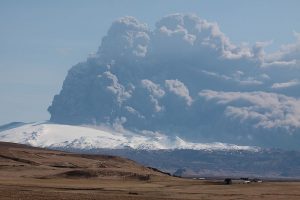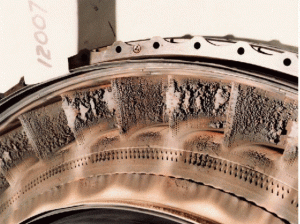 When a volcano erupts, we think of lava and billowing clouds of ash. Those things do happen, but what we don’t think about is what can happen to planes, because of the ash. I suppose that is because we think of that eruption as being a very localized thing. In reality, it isn’t, because the jet stream moves the air around our world, and the ash goes with it. Volcanic ash and airplane engines are not a good mix. Volcanic ash consists of small tephra, which are bits of pulverized rock and glass less than 2 millimeters in diameter created by volcanic eruptions. As the ash enters the atmosphere, it is carried away from the volcano by winds. The ash with the smallest size can remain in the atmosphere for a considerable period of time. The ash cloud can be dangerous to aviation if it reaches the heights of aircraft flight paths.
When a volcano erupts, we think of lava and billowing clouds of ash. Those things do happen, but what we don’t think about is what can happen to planes, because of the ash. I suppose that is because we think of that eruption as being a very localized thing. In reality, it isn’t, because the jet stream moves the air around our world, and the ash goes with it. Volcanic ash and airplane engines are not a good mix. Volcanic ash consists of small tephra, which are bits of pulverized rock and glass less than 2 millimeters in diameter created by volcanic eruptions. As the ash enters the atmosphere, it is carried away from the volcano by winds. The ash with the smallest size can remain in the atmosphere for a considerable period of time. The ash cloud can be dangerous to aviation if it reaches the heights of aircraft flight paths.
Part of the problem is that pilots can’t see ash clouds at night, and ash particles are too small to return an echo to on-board weather radars on commercial airliners. Even when they are flying in daylight, pilots may interpret a visible ash cloud as a normal cloud of water vapor and not a danger…especially if the ash has travelled far from the eruption site. Volcanic ash has a melting point of approximately 2,010° F, which is below the operating temperature of modern commercial jet engines, about 2,550° F. Volcanic ash can damage gas turbines in a number of ways. These can be categorized into those that pose an immediate hazard to the engines and those that present a maintenance problem. As was the case with KLM Flight 867, bound for Anchorage, Alaska, when all four engines flamed out after the aircraft inadvertently entered a cloud of ash blown from erupting Redoubt Volcano, 150 miles away. The volcano had begun erupting 10 hours earlier on that morning of December 15, 1989. Only after the crippled jet had dropped from an altitude of 27,900 feet to 13,300 feet…a fall of more than 2 miles…was the crew able to restart all engines and land the plane safely at Anchorage. The plane required $80 million in repairs, including the replacement of all four damaged engines.
 The 2010 eruptions of Eyjafjallajökull in Iceland, were relatively small for volcanic eruptions. Nevertheless, they caused enormous disruption to air travel across western and northern Europe over the next six days. Additional localized disruption occurred into May 2010. The eruption was declared officially over in October 2010. About 20 countries closed their airspace to commercial jet traffic and it affected about 10 million travelers. This was the highest level of air travel disruption since World War II. It’s strange for us to think that so much can happen to a jet engine is volcanic ash is introduced into it, but that is definitely the case, and if air planes travel in the area of certain types of volcanic ash, planes can be lost. The only prudent thing to do is stop travel in the area…no matter how inconvenient it is to travelers.
The 2010 eruptions of Eyjafjallajökull in Iceland, were relatively small for volcanic eruptions. Nevertheless, they caused enormous disruption to air travel across western and northern Europe over the next six days. Additional localized disruption occurred into May 2010. The eruption was declared officially over in October 2010. About 20 countries closed their airspace to commercial jet traffic and it affected about 10 million travelers. This was the highest level of air travel disruption since World War II. It’s strange for us to think that so much can happen to a jet engine is volcanic ash is introduced into it, but that is definitely the case, and if air planes travel in the area of certain types of volcanic ash, planes can be lost. The only prudent thing to do is stop travel in the area…no matter how inconvenient it is to travelers.


Leave a Reply